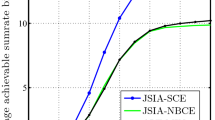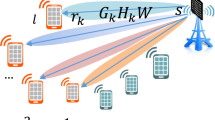Abstract
In general, multiplexing and diversity gains of single user MIMO systems are restricted by min(M,N) where M, N denote the number of antenna elements at a transmitter and receiver, respectively. In order to increase the multiplexing/diversity gains and improve the performance of single user MIMO systems, a joint pre-processing co-channel interference cancellation (JPCIC) method is proposed. The JPCIC is analyzed in both the perfect and the imperfect channel state information. The dependence of channel capacity on the number of antenna elements in every subset, the number of subsets, transmit powers and channel estimation errors is discussed. As theoretical calculation result, the channel capacity increases when the multiplexing/diversity gains and/or the transmit power increase in a certain channel model whether the channel estimation error is absent or present. Compared to the conventional zero-forcing method, the channel capacity of JPCIC is considerably higher because of higher multiplexing/diversity gains, however, it is less robust and decreased more rapidly due to incomplete cancellation of interference terms when the channel estimation error increases. There is a trade-off between the channel capacity and the complexity of system, however, according to quick development in circuit techniques and miniaturization of devices, the JPCIC is expected to be an attractive technology for MIMO system.









Similar content being viewed by others
References
Gore, D. A., Heath, R. W, Jr, & Paulraj, A. (2002). Transmit selection in spatial multiplexing systems. IEEE Communications Letters, 6(11), 491–493.
Siriteanu, C., Blostein, S. D., Takemura, A., Hyundong, S., Yousefi, S., & Kuriki, S. (2014). Exact MIMO zero-forcing detection analysis for transmit-correlated rician fading. IEEE Transactions on Wireless Communications, 13(3), 1514–1527.
Park, J., & Chun, J. (2012). Improved lattice reduction-aided MIMO successive interference cancellation under imperfect channel estimation. IEEE Transactions on Signal Processing, 60(6), 3346–3351.
Jian, Z., & Zheng, Y. R. (2011). Frequency-domain turbo equalization with soft successive interference cancellation for single carrier MIMO underwater acoustic communications. IEEE Transactions on Wireless Communications, 10(9), 2872–2882.
McKay, M. R., Collings, I. B., & Tulino, A. M. (2010). Achievable sum rate of MIMO MMSE receivers: A general analytic framework. IEEE Transactions on Information Theory, 56(1), 396–410.
Mehana, A. H., & Nosratinia, A. (2012). Diversity of MMSE MIMO receivers. IEEE Transactions on Information Theory, 58(11), 6788–6805.
Lin, S. C., & Su, H. J. (2007). Practical vector dirty paper coding for MIMO Gaussian broadcast channels. IEEE Journal on Selected Areas in Communications, 25(7), 1345–1357.
Jindal, N., & Goldsmith, A. (2005). Dirty-paper coding versus TDMA for MIMO broadcast channels. IEEE Transactions on Information Theory, 51(5), 1783–1794.
Zanella, A., & Chiani, M. (2012). Reduced complexity power allocation strategies for MIMO systems with singular value decomposition. IEEE Transactions on Vehicular Technology, 61(9), 4031–4041.
Rosas, F., & Oberli, C. (2013). Nakagami-m approximations for multiple-input multiple-output singular value decomposition transmissions. IET Communications, 7(6), 554–561.
Chen, Y. L., Zhan, C. Z., Jheng, T. J., & Wu, A. Y. (2013). Reconfigurable adaptive singular value decomposition engine design for high-throughput MIMO-OFDM systems. IEEE Transactions on Very Large Scale Integration Systems, 21(4), 747–760.
Zhang, J., Wang, Y., Ding, L., & Gao, J. (2013). On the error probability of spatial modulation over keyhole MIMO channels. IEEE Communications Letters, 17(12), 2221–2224.
Chang, D. C., & Guo, D. L. (2013). Spatial-division multiplexing MIMO detection based on a modified layered OSIC scheme. IEEE Transactions on wireless Communications, 12(9), 4258–4271.
Nam, T. L., Juntti, M., Bengtsson, M., & Ottersten, B. (2013). Weighted sum rate maximization for MIMO broadcast channels using dirty paper coding and zero-forcing methods. IEEE Transactions on Communications, 61(6), 2362–2373.
Jisheng, D., Chang, C., Ye, Z., & Hung, Y. S. (2009). An efficient greedy scheduler for zero-forcing dirty-paper coding. IEEE Transactions on Communications, 57(7), 1939–1943.
Zanella, A., Chiani, M., & Win, M. Z. (2005). MMSE reception and successive interference cancellation for MIMO systems with high spectral efficiency. IEEE Transactions on wireless Communications, 4(3), 1244–1254.
Gamal, H. E., & Hammons, A. R. J. (2003). On the design of algebraic space-time codes for MIMO block-fading channels. IEEE Transactions on Information Theory, 49(1), 151–163.
Gong, Y., & Letaief, K. B. (2007). On the error probability of orthogonal space-time block codes over keyhole MIMO channels. IEEE Transactions on Wireless Communications, 6(9), 3402–3409.
Wang, W. Q. (2011). Space-time coding MIMO-OFDM SAR for high-resolution imaging. IEEE Transactions on Geoscience and Remote Sensing, 49(8), 3094–3104.
Author information
Authors and Affiliations
Corresponding author
Appendices
Appendix 1: Creation method of orthogonal matrices
In Sect. 2.2, the \({\varvec{\Phi }}_{\mathrm{12,2}}{\varvec{\Phi }}_{\mathrm{12,1}}\) is indicated to be orthogonal to \(\mathbf{H}_{\mathrm{12}}\mathbf{P}_{\mathrm{12}}\). the design of \({\varvec{\Phi }}_{\mathrm{12,1}}\) and \({\varvec{\Phi }}_{\mathrm{12,2}}\) are represented as follows. Let
There are many methods to design \({\varvec{\Phi }}_{\mathrm{12,1}}\) and \({\varvec{\Phi }}_{\mathrm{12,2}}\). One of them is to create \({\varvec{\Phi }}_{\mathrm{12,1}}\) subject to
Therefore,
And then, create \({\varvec{\Phi }}_{\mathrm{12,2}}\) subject to
We can indicate an example as
As explained above, a vector with length of p can be designed to be orthogonal to \(\mathrm{p}-1\) vectors with the same length. Consequently, every row of matrix \({\varvec{\Phi }}_{\mathrm{p}_{\mathrm{sub}},1}\) is created to be orthogonal to the first \(\mathrm{p}-1\) columns of \(\mathbf{Z}\). Therefore,
and \({\varvec{\Phi }}_{\mathrm{p}_{\mathrm{sub}},2}\) is designed to be orthogonal to the last column of \({\varvec{\Phi }}_{\mathrm{p}_{\mathrm{sub}},1} \mathbf{H}_{{\mathrm{p}}_{\mathrm{sub}}}\mathbf{P}_{{\mathrm{p}}_{\mathrm{sub}}}\), \(\left[ \begin{array}{c}{\hat{\mathrm{z}}}_\mathrm{1p}\, {\hat{\mathrm{z}}}_\mathrm{2p}\,\cdots \, {\hat{\mathrm{z}}}_{\mathrm{p}\mathrm{p}} \end{array} \right] ^{\mathrm{T}}\), as similar to (30).
Appendix 2: Calculation method of q11, q12
The (10) can be represented as
here \(\hat{{\mathbf{P}}} \equiv \mathbf{P}_{\mathrm{12}}^\mathrm{-1} \mathbf{P}_{\mathrm{23}}\). Therefore, it is changed as follows.
Since this equation is for all \(\mathrm{s}_{3}\) and \(\mathrm{s}_{4}\), we have
As a result,
and matrices \(\mathbf{P}_{\mathrm{12}}\) and \(\mathbf{P}_{\mathrm{23}}\) should be designed subject to \(\hat{\mathrm{p}}_{12}\mathrm{k}_{21}-\hat{\mathrm{p}}_{11}\mathrm{k}_{22}\ne 0\), \(\hat{\mathrm{p}}_{12}\mathrm{k}_{11}-\hat{\mathrm{p}}_{11}\mathrm{k}_{12}\ne 0\) and \({k}_{21}{ k}_{12}-{k}_{22}{k}_{11}\ne 0\). Notice that \(\mathbf{K}_{\mathrm{23}}={\varvec{\Phi }}_{\mathrm{12,2}} {\varvec{\Phi }}_{\mathrm{12,1}} \mathbf{H}_{\mathrm{12}}\mathbf{P}_{\mathrm{23}}\).
Appendix 3: Taylor expansion of pseudo inverse matrix
We are going to prove that
We have
and the Taylor expansion is applied to.
Rights and permissions
About this article
Cite this article
Hiep, P.T., Son, V.V. Joint pre-processing co-channel interference cancellation for single user MIMO. Wireless Netw 22, 2597–2606 (2016). https://doi.org/10.1007/s11276-015-1118-6
Published:
Issue Date:
DOI: https://doi.org/10.1007/s11276-015-1118-6




